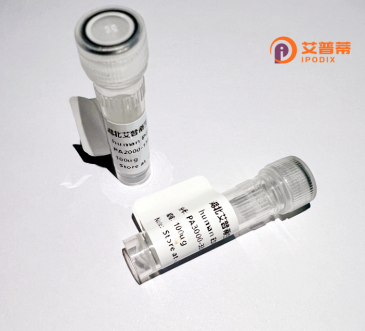
| 纯度 | >90%SDS-PAGE. |
| 种属 | Human |
| 靶点 | CCNO |
| Uniprot No | P22674 |
| 内毒素 | < 0.01EU/μg |
| 表达宿主 | E.coli |
| 表达区间 | 1-350aa |
| 氨基酸序列 | MVTPCPTSPSSPAARAGRRDNDQNLRAPVKKSRRPRLRRKQPLHPLNPCPLPGDSGICDLFESPSSGSDGAESPSAARGGSPLPGPAQPVAQLDLQTFRDYGQSCYAFRKAQESHFHPREALARQPQVTAESRCKLLSWLIPVHRQFGLSFESLCLTVNTLDRFLTTTPVAADCFQLLGVTSLLIACKQVEVHPPRVKQLLALCCGAFSRQQLCNLECIVLHKLHFTLGAPTISFFLEHFTHARVEAGQAEASEALEAQALARGVAELSLADYAFTSYSPSLLAICCLALADRMLRVSRPVDLRLGDHPEAALEDCMGKLQLLVAINSTSLTHMLPVQICEKCSLPPSSK |
| 分子量 | 64.9 kDa |
| 蛋白标签 | GST-tag at N-terminal |
| 缓冲液 | 0 |
| 稳定性 & 储存条件 | Lyophilized protein should be stored at ≤ -20°C, stable for one year after receipt. Reconstituted protein solution can be stored at 2-8°C for 2-7 days. Aliquots of reconstituted samples are stable at ≤ -20°C for 3 months. |
| 复溶 | Always centrifuge tubes before opening.Do not mix by vortex or pipetting. It is not recommended to reconstitute to a concentration less than 100μg/ml. Dissolve the lyophilized protein in distilled water. Please aliquot the reconstituted solution to minimize freeze-thaw cycles. |
以下是关于重组人周期素O(CCNO)蛋白的3篇参考文献及简要概括:
1. **《Mutations in CCNO result in congenital mucociliary clearance disorder due to reduced generation of multiple motile cilia》**
- **作者**:Hjeij R, Onoufriadis A 等
- **摘要**:本研究揭示了CCNO基因突变导致纤毛发生缺陷,通过重组CCNO蛋白功能实验,证实其调控多纤毛细胞的分化,突变会导致呼吸道上皮纤毛减少或缺失,引发原发性纤毛运动障碍。
2. **《CCNO mutations disrupt the differentiation of airway epithelial cells in vitro》**
- **作者**:Boon M, Jorissen M 等
- **摘要**:通过体外重组人CCNO蛋白表达模型,研究CCNO在气道上皮细胞分化中的作用,发现其缺失会阻碍基底体扩增和纤毛形成,加剧呼吸道炎症表型。
3. **《Cyclin O regulates G1/S progression through CDK2 interaction》**
- **作者**:Shao Y, Walls ER 等
- **摘要**:利用重组人CCNO蛋白进行互作分析,发现其通过结合CDK2调控G1/S期转换,揭示CCNO在细胞周期中的关键作用及异常表达与肿瘤增殖的相关性。
以上研究涵盖CCNO的疾病关联、分子机制及重组蛋白应用方向,均发表于遗传学及细胞生物学领域权威期刊。
Cyclin O (CCNO) is a member of the cyclin protein family, first identified in 2010. that regulates cell cycle progression and is implicated in ciliogenesis. Unlike classical cyclins, CCNO lacks conserved cyclin box domains critical for cyclin-dependent kinase (CDK) binding, suggesting distinct regulatory mechanisms. The human CCNO gene is located on chromosome 5q11.2 and encodes a 150-amino acid protein. Functionally, CCNO localizes to centriolar satellites and basal bodies, playing a role in primary cilium formation by modulating microtubule dynamics through interactions with proteins like PCM1 and polycystin-2.
Mutations in CCNO are linked to severe ciliopathies, including primary microcephaly, retinal dystrophy, and congenital kidney disease. Notably, autosomal recessive CCNO mutations cause reduced generation of multiple motile cilia (RGMC), leading to respiratory distress and chronic infections due to impaired mucociliary clearance. CCNO-deficient cells exhibit delayed cell cycle re-entry from quiescence and defective DNA damage repair, highlighting its role in coordinating ciliogenesis with cell cycle checkpoints.
Recent studies emphasize its potential as a therapeutic target for cilia-related disorders, though its precise molecular partners and signaling pathways remain incompletely characterized. Research continues to explore its dual functions in cell cycle regulation and cilia biology, offering insights into developmental defects and tissue homeostasis.
×